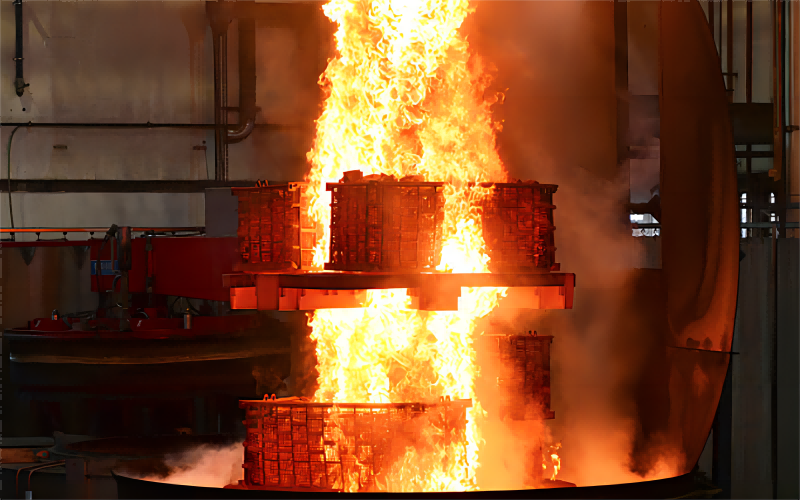There are ten commonly used methods of quenching in the heat treatment process. These include single-medium (water, oil, air) quenching, dual-medium quenching, and martensite-graded quenching below the Ms point bainite isothermal quenching, compound quenching, pre-cooling isothermal quenching, delayed cooling quenching, quenching self-tempering, and spray quenching.
1. Single Medium (Water, Oil, Air) Quenching
Single medium (water, oil, air) quenching involves immersing a workpiece that has been heated to the quenching temperature into a quenching medium to cool it completely. This is the simplest quenching method and is often used for carbon steel and alloy steel workpieces with simple shapes. The quenching medium is selected based on factors such as the heat transfer coefficient of the part, its hardenability, size, and shape.
2. Dual-Medium Quenching
Dual-medium quenching involves first cooling a workpiece heated to the quenching temperature in a fast-cooling quenching medium until it is close to the Ms point. It is then transferred to a slow-cooling quenching medium to cool to room temperature. This achieves different cooling rates within different temperature ranges during quenching. It is used for complex-shaped parts or large workpieces made of high-carbon steel and alloy steel. Carbon tool steel also uses this method. Commonly used cooling media combinations include water-oil, water-nitrate, water-air, and oil-air. Water is generally used as the fast-cooling medium while oil or air is used as the slow-cooling medium.
3. Martensite-Graded Quenching
Martensite-graded quenching involves austenitizing steel and then immersing it in a liquid medium (such as a salt or alkali bath) with a temperature slightly higher or lower than the steel’s upper martensitic point. It is then held for an appropriate time until the inside and outside of the steel reach the temperature of the medium. The workpiece is then removed and air-cooled, allowing the supercooled austenite to slowly transform into martensite. This method is generally used for small workpieces with complex shapes and strict deformation requirements. High-speed and high-alloy steel tools and molds are often quenched using this method.
4. Martensite-Graded Quenching Below the Ms Point
Martensite-graded quenching below the Ms point involves immersing a workpiece in a bath with a temperature lower than the Ms point of the steel but higher than its Mf point. The workpiece cools faster in the bath, achieving the same result as graded quenching even when its size is larger. This method is commonly used for larger low-hardenability steel workpieces.
5. Bainite Austempering
Bainite austempering involves quenching a workpiece into a bath at the lower bainite temperature of the steel and holding it isothermally to allow lower bainite transformation to occur. It is generally held in the bath for 30-60 minutes. The bainite austempering process has three main steps: austenitizing treatment, cooling treatment after austenitizing, and bainite isothermal treatment. This method is commonly used for small-sized alloy steel, high-carbon steel, and ductile iron castings.
6. Composite Quenching
Composite quenching involves rapidly cooling a workpiece below its Ms point to obtain martensite with a 10-30% volume fraction. It is then held isothermally in the lower bainite zone to obtain a martensite and bainite structure. This method is used for larger cross-section alloy tool steel workpieces.
7. Pre-Cooling and Isothermal Quenching
Pre-cooling and isothermal quenching, also known as elevated temperature isothermal quenching, involves first cooling a workpiece in a bath with a lower temperature (greater than its Ms point) and then transferring it to a bath with a higher temperature to allow the austenite to undergo isothermal transformation. This method is suitable for steel parts with poor hardenability or large workpieces that must be austempered.
8. Delayed Cooling and Quenching
Delayed cooling and quenching involves pre-cooling a workpiece in air, hot water, or a salt bath to a temperature slightly higher than its Ar3 or Ar1 point. It is then quenched using a single medium. This method is often used for parts with complex shapes, varying thicknesses, and small deformation requirements.
9. Quenching and Self-Tempering
Quenching and self-tempering involve heating the entire workpiece but only immersing the part that needs to be hardened (usually the working part) into the quenching liquid to cool it. The workpiece is then removed from the liquid and air-cooled when the color of the unimmersed part disappears. This method uses heat from the core that has not completely cooled to transfer to the surface and temper it. It is commonly used for tools that must withstand impacts, such as chisels, punches, and hammers.
10. Spray Quenching
Spray quenching involves spraying water onto a workpiece. The water flow can be adjusted depending on the required quenching depth. Spray quenching does not form a vapor film on the surface of the workpiece, allowing for a deeper hardened layer than with previous water quenching methods. It is mainly used for partial surface quenching.
Similar Articles:
- Normalizing
- Heat treatment
- Quenching & Tempering
- Normalizing & Annealing
- Quenching and tempering(QT)
- Quenched and tempered steel
- Heat treatment quality inspection
- Heat treatment workshop work instructions
- Explanation of metallographic structure terms
- Factors Affecting Heat Treatment Deformation
- Common heat treatment process of steel castings
- The reasons and effects of steel parts needing quenching and tempering

